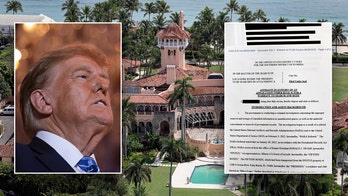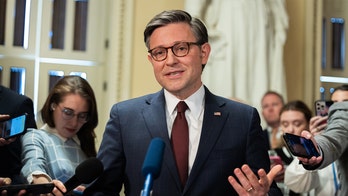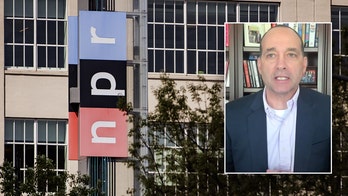We had “Black Wednesday” in March.
Wednesday, March 11, was the day everything melted down with coronavirus.
You know the rest. Cases started surging. Rudy Gobert of the Utah Jazz tested positive. The NBA suspended its season. Tom Hanks announced he was positive. Hospitals were bursting. Dr. Anthony Fauci testified that morning before the House Oversight Committee. Chairwoman Carolyn Maloney, D-N.Y., asked Fauci if the worst was “yet to come?”
“Yes, it is,” replied Fauci.
The “worst” came.
BRETT BAIER: COVID-19 HAS 'CHANGED THE DYNAMIC'OF PRESIDENTIAL RACE, SUPREME COURT BATTLE
“The worst” burned through Queens, Brooklyn and the Bronx. It rolled through meatpacking plants in the Dakotas. It canceled baseball’s spring training. Wiped out March Madness. Cast millions of Americans onto unemployment rolls in an instant.
And now, more than 209,000 lives later…
We don’t know what we’ll call Friday, Oct. 2, 2020, in the future. But history was made on Friday. It may not be Black Wednesday or Black Friday or anything else. But Friday was an inflection point for the country and the fight against coronavirus.
Friday was a defining moment in the 2020 campaign. And burnished into our memories will be that image of Marine One, sitting on the south White House Lawn, waiting to ferry President Trump to Walter Reed National Military Medical Center.
That is a touchstone image of 2020. It will shape an understanding of the era for future generations.
Friday was “one of those days.” It upended the presidential campaign. It raised questions about the breakneck pace to confirm Amy Coney Barrett to the Supreme Court. It further nudged congressional leaders and administration officials to secure a big coronavirus agreement. And, it raised the question of whether there should be a COVID-19 testing regime at the U.S. Capitol.
Senate Majority Leader Mitch McConnell, R-K.Y., and Judiciary Committee Chairman Lindsey Graham, R-S.C., both signaled they would forge ahead with a confirmation hearing next week for Barrett. The senators spoke separately with the president about Barrett’s nomination.
“The first thing he asked me is ‘How’s the hearing going?’ I said ‘We’re on track. We’re going to start Oct. 12 and we’re going to work hard to get this wonderful, conservative young lady, talented beyond belief, Amy Barrett, on the Supreme Court,’” said Graham.
Barrett huddled with 32 senators in a flurry of round-robin interviews at the Capitol last week. But then word came that Sen. Mike Lee, R-Utah, tested positive for coronavirus. Lee is a member of the Judiciary Committee, which will consider Barrett’s nomination. Lee met with Barrett at the Capitol Tuesday. By nightfall, the same for Sen. Thom Tillis, R-N.C., another Judiciary Committee member who met with Barrett.
Fox was told officials were testing Barrett on a daily basis and she was negative.
Democrats were already flashing yellow lights about the pace of the confirmation process. But health concerns ignited Senate Minority Leader Chuck Schumer, D-N.Y., and Sen. Dianne Feinstein, D-Calif., the top Democrat on the Judiciary Committee.
“It is premature for Chairman Graham to commit to a hearing schedule when we do not know the full extent of potential exposure stemming from the president’s infection and before the White House puts in place a contact tracing plan to prevent further spread of the disease,” said Schumer and Feinstein. “The unfortunate news about the infection of our colleague Sen. Mike Lee makes even more clear that health and safety must guide the schedule for all Senate activities, including hearings.”
CLICK HERE TO GET THE FOX NEWS APP
The duo declared that otherwise, “the already illegitimate process will become a dangerous one.”
House Speaker Nancy Pelosi, D-Calif., and Treasury Secretary Steve Mnuchin were tested on Friday. Mnuchin had been around the president some. And, after weeks of no negotiations at all toward securing an agreement for a new coronavirus bill, Pelosi and Mnuchin actually got together in person to try to craft a deal. Pelosi and Mnuchin received negative results. And then hit the phones again late in the week.
Oct. 1 was also an inflection point on the COVID relief front anyway. Congress was about to finish its legislative business before the election. Airlines and other firms threatened to lay off tens of thousands of workers if there was no help emanating from Capitol Hill. In other words, if there was going to be a deal, it was going to come now.
Just the fact that Pelosi and Mnuchin were talking – and doing so on a daily basis – signaled they were closer to a pact than they ever had been. Nothing had truly moved on coronavirus bill negotiations since May. And, the talks intensified just after McConnell suggested that Pelosi’s request for $2.2 trillion was “outlandish.”
That number, $2.2 trillion, is a “floor” for Democrats. They go much lower and they lack Democratic votes to pass a bill. And $1.5 trillion is a “ceiling” for Republicans. GOPers are struggling to spend more than $1 trillion – let alone $1.5 trillion or more than $2 trillion. So, there is a huge crawl space between the Democratic floor and the Republican ceiling.
“The higher the cost, the fewer the Republican votes,” said Sen. Kevin Cramer, R-N.D. “I think it’s clear there is anxiety out there. That there is need. That this has gone on longer than we planned when we passed the CARES Act.”
The CARES Act is the $2 trillion-plus bill Congress approved in March to combat coronavirus. That was the third of four big measures OK'd by lawmakers to tackle coronavirus. And lawmakers from both sides are really starting to feel the heat from voters and industry as the economy teeters on the precipice of an uncertain fall and winter.
Necessity rejuvenated the coronavirus negotiations.
“I’m trying to figure out here whether I should predict another bill quickly or not. But the talks have speeded up in the last couple of days,” said McConnell. “I think we’re getting closer to an outcome.”
House Majority Leader Steny Hoyer, D-Md., indicated that maybe Pelosi and Mnuchin could forge a deal over the weekend and perhaps lawmakers could vote in the coming days.
“Hopefully those negotiations will bear fruit, sooner rather than later,” said Hoyer.
The Maryland Democrat noted that even if they secured a pact, it would take days to “memorialize” and write such a major piece of legislation.
Trump’s condition also sparked a new conversation, after seven months, to implement a testing regime for Capitol Hill.
No one is tested for coronavirus at the Capitol. Lawmakers. Aides. Custodians. U.S. Capitol Police. Journalists.
It’s absurd.
Pelosi and McConnell ruled out testing earlier this year. Ironically, House Minority Leader Kevin McCarthy, R-Calif., and Schumer advocated testing.
Supposedly, the testing program would be universal for all persons at the Capitol. Members on down.
Although it’s not been said, there is concern about “optics.” Members getting tested – but the general public struggling to find tests.
However, some lawmakers point out that they are constantly traveling back and forth from Washington on flights. There is a risk of members getting it and taking it back home to infect constituents – or vice versa.
As Senate Health Committee Chairman Lamar Alexander, R-Tenn., put it this spring, Congress has the potential to become an “efficient, virus-spreading machine.”
Rep. Rodney Davis, R-Ill., is the top GOPer on the House Administration Committee. Davis contracted coronavirus over the summer. But before that happened, Davis was the most ardent advocate for Congress to set up a coronavirus testing system.
“This isn't just about members of Congress. This is about the Capitol Police officers. The folks who are here every day, cleaning the buildings in the complex,” said Davis. “I think it also gives us a chance to get us on track to begin to reopen the Capitol.”
“(435) members of Congress, coming in from all over the country,” mused Rep. Alexandria Ocasio-Cortez, D-N.Y. “It has the potential to be a super-spreader event.”
Rep. Sean Patrick Maloney, D-N.Y., ripped coronavirus skeptics and some of his GOP colleagues when asked by reporters about a potential testing system at the Capitol.
“It's about time that all sensible adults stop behaving like they can't see the threat right in front of them,” exhorted Maloney. “So if you want to put that question to my colleagues who refuse to wear masks, have at it. You'd be doing us all a favor.”
So we don’t know the health of the president and what that means for the campaign.
We don’t know if all of this will impact the confirmation of Amy Coney Barrett for the Supreme Court. Keep in mind that any delay could prompt the Senate to consider her nomination after the election. We don’t know if there will be a comprehensive coronavirus bill. And, we don’t know if they will begin coronavirus testing at the Capitol.
“Black Wednesday” was an inflection point in March. Friday was one of those days, too.
We now have a better understanding of March 11.
And in six or seven months, we’ll also have a better understanding of another inflection point, Oct. 2.








